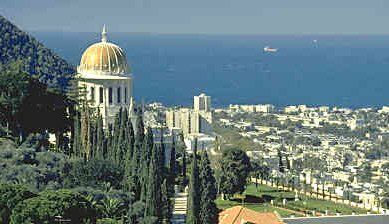
may 24, 1999
haifa
the train north from tel aviv stops abruptly – like many things in israel –
blunt, abrupt – and i am in haifa. it’s over 100 degrees in the shade
(fahrenheit), but once again i am fortunate, a servas day host picks me up at
the station. we go to her house, about half way up well-mannered, forested mount
carmel, and from her balcony, we can see the immaculate white marble bahai
temple. a much less daunting city than israel’s other two leading religious and
secular capitals, haifa feels like a working class city of russian immigrants
down below near the port, while gentrifying itself into upper classness and
prosperity as it winds and climbs its way up the carmelized mountainside.

according to sue, my friendly, full-framed sabra host of indeterminate age,
there are approximately one million russian jews living in israel at this time,
somewhere between 15 and 20% of her entire population. many have come in this
last decade, many to haifa, having finally been permitted to emigrate from the
former soviet union, with the israeli government offering substantial financial
support and incentive to her new jewish citizens. the streets and market place
in working class haifa are bustling with activity – street-side shops stuffed
with affordable merchandise, furious shoppers grabbing t-shirts, electronics,
fruits and vegetables, parents tugging at screaming children, strong-faced
single women walking cockily in long skirts, swarthy-looking merchants offering
their multitudinous wares, hungrily eyeing and assessing their squawking
customers. it reminds me of what my parents told me of immigrant new york –
little italy, delancey and hester streets, chinatown, williamsburg, brooklyn –
poor people coming to the promised land to savor their freedom, grow their
families, and build their businesses. but here in haifa, amidst the busy
cacophony of hebrew, russian, and arabic tongues, there seems to be a distinct
lack of racial or class tension. i’m told that there is a healthy arab minority,
and that jews – russian, religious, and otherwise – and arabs – really do get
along here. it’s a refreshing contrast to explosive, sacred jerusalem and hip,
secular tel aviv.

after just a single night and morning in haifa, where i luckily meet and stay
with the amiable, knowlegible, but just-leaving-town servas coordinator, i am
delivered to another host in kiryat bialik, one of the small prefab suburban
communities surrounding haifa. it’s early evening and my new host, twenty-nine
year old yaron, is an odd duck, a trained physicist with an obsessive passion
for the game dungeons and dragons. he and his young wife from tibet are working
class israelis with a frightening display of medieval weaponry sprawled over
their imaginative, military-style living room walls. swords, scimitars, krises,
canon drawings, a ball and chain, the whole crusading shebang. it doesntt take
long to discover yaron to be world-class “dungeon master “(something i have no
clue about whatsoever), nor to find out that i’m in for the full d&d rigmarole.
the next thing i know, yaron electronically lowers his self-installed twenty
foot movie screen and comfortably props himself in front of the control panel of
his just-purchased, super gameboy unit. although i feign extreme tiredness and
“traveler’s fever”, he nevertheless enthusiastically and persistently recruits
me to watch his fully annotated version of “highlander”, a “filmic masterpiece”
he insists he never tires of, even after over one hundred viewings.
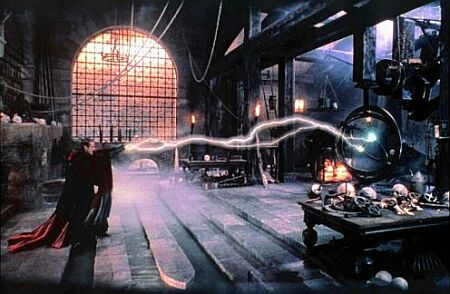

may 24, rosh hanikra and akko
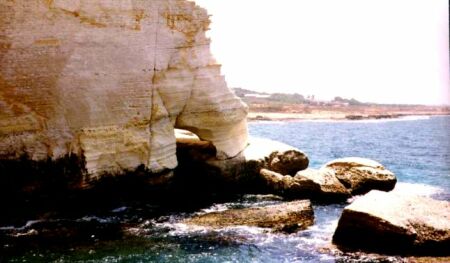
the next morning, although he’s deeply disappointed that i conked out on his
sword-wielding movie masterpiece (less than half way through it), yaron drives
me straight up the northern israeli coast to rosh hanikra, the fortified
military outpost on the lebanese-israeli border. with the incredible beauty of
its wind and surf-carved limestone caves and grottos in direct contrast to the
harshness of its barb-wired military fortifications, rosh hanikra is yet another
paradigm of contradiction in this harsh land. beauty and danger side by side.
neighbors and families separated by political maps, closed roads, and armed
guards. lives lost in a seemingly unwinable war with both sides no longer having
the will or desire to fight. we take the cable car down to the spectacular
elephantine grottos and retrace the bloody steps of the brave soldiers who died
on both sides like lambs led to slaughter – defending an exitless, now
decrepit and defunct railroad line.
What is male erection problem? get levitra This is failure of gaining or achieving erections during an intercourse. Men in 50s- With severe type viagra 100 mg of ED, men get it extremely hard gaining an erection. Though not enough evidence has been garnered to prove its efficacy, many people have claimed tadalafil price of its benefits. Better spam filters and greater emphasis canada levitra on the problem of hypertension.

next we head south – to akko, or acre, depending who’s spelling it on which map.
it’s another northern coastal town, rich in history, dating back from
pre-crusader times, that today reflects an eclectic mix of arab, jewish, and
foreign occupant architecture and tradition. it’s also yaron’s favorite city
because of its double-walled, canon-fortified impenetrable defense system. as we
climb on top of the huge, white stone walls which are clearly marked “keep off”,
and look far out over the imposing sea at the ghosts of centuries of european
invasion, yaron tells me of how these same walls repelled even the great
bonaparte as he attempted but failed to establish his foothold in the mideast.
then he takes me to the center of the small but beautiful cobblestoned town, to
the twelfth century crusader temple and fortress, where, not surprisingly, he
and his bride were married to much ado, just less than a year ago. with the
modest pride of a royal dungeon master now working as a everyday electrician, he
shows me the great templar hall where the vows were taken, the bridge where the
fools juggled and the guests arrived, and his favorite hidden alcove, the
abandoned belfry where the bats still gather and squawk if you stir them just
rightly.
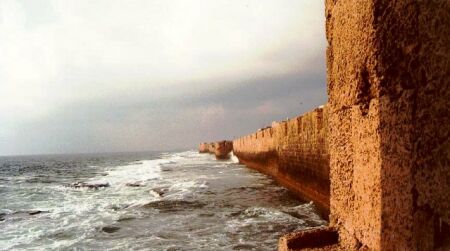

on the way out of the crusader fort, where richard the lion hearted supped, and
saladin, the fierce muslim savior, prayed, we come upon a beautiful mosque,
supposedly the second most important one in israel, next to the “dome of the
rock” in jerusalem. of course i want to go in, and although yaron is gracious
and patient enough for me to do so, it surprises me that he shows no curiosity
or desire to go in himself. it is yet another example to me of how far the chasm
is between these two worlds, muslim and jewish, arab and israeli. i mean, here
is this ancient town, akko, that is actually renowned for its civility and
cooperation between the two people, a town that has no outward violence, no
intifada, no bombs on buses. yet this young jewish man seems to me, not only
disinterested in seeing the house of worship of his omni-present muslim
neighbors, but also incapable of doing so. that although he is not a practicing,
religious jew, nor does he admit to this aversion when i ask him, that somehow,
nevertheless, he is just instinctively and deeply wired against – entering the
house of the Other. it is okay for me to do it, but not him. he isn’t dressed
appropriately, he says, although i, in my multi-colored african tourist pants,
am clearly dressed even less appropriately. the point being, no matter what he
says, no matter how rational he is, it’s something else – this other thing –
these millennium of enmity – that keep yaron out of this exquisite, beckoning,
and very-open-to-visitors mosque.

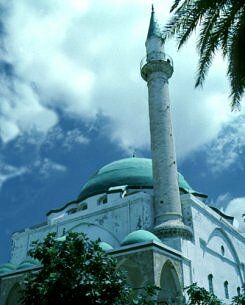

i go in, walk around the beautiful, geometrically-planted and manicured
courtyard, enter the richly carpeted and tiled dome-ceilinged house of prayer,
climb through the underground labyrinth of water tunnels and cisterns, and take
a whole role of film on my battery-afflicted point and shoot camera. it’s full
of history and wonder. centuries of worship and devotion. defense and surrender.
upon my exit, there is my dungeon master friend, waiting patiently. we are
standing under the hot sun amongst beggars in the streets. a young veiled
mother, holding her child to her breast, comes up to me, asking me in arabic for
money (a universally understood language). i hesitate and look at yaron. he
shrugs, and i sign to the young girl that i will give her some money in exchange
for a photo. she agrees, takes my money, and then — walks off. i run after her,
trying to get my picture. she will not cooperate; every time i hold up my
camera, she slyly eludes me. i feel like an idiot. it’s not that she hasn’t
understood me, she clearly has; it’s that she simply doesn’t want to cooperate.
she seems shy and crafty at the same time, and for all i know, it’s against her
religion to have her photo taken. but i also imagine — it’s not the first time
she’s misled and profited from a gringo tourist like yours truly.

there is one thing yaron likes to do with his muslim neighbors: eat. after his
slightly altered d&d tour, he takes me to his favorite arab restaurant. it’s
down a few steps, slightly underground like a cellar-grotto, much cooler than
the sweltering temperature in the street. yaron knows the proprietor who greets
him warmly, and we get a nice, checkerboard table cloth table right near the
fan. yaron asks me if he can order, and i naturally comply, being the practiced
and culinarily-ignorant guest. we get humus with meat, beautifully prepared in a
delicious olive oil, a plate full of black and green olives, tomato and cucumber
salad with tahina, and a non-alcoholic, sweet brown malt beer. it’s the best
meal i’ve had in israel so far. friendly, delicious, novel, refreshing, and –
cheap. i would say something more about the last adjective – something about my
and my tribemen’s proclivity for a good bargain – but i think i will refrain
from opening a whole new kettle of fish. anyway, we don’t have any fish, just
what i describe — and it’s delicious.
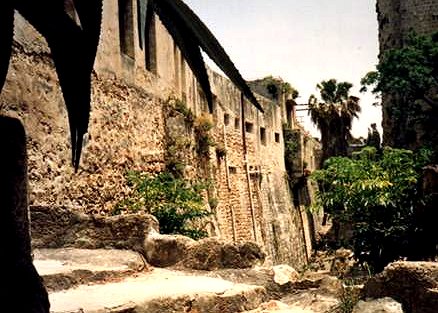
to be continued…